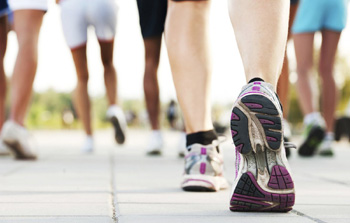
What’s a fun, natural, and inexpensive way to keep your health and your feet in excellent shape? Walking! About 67 million adults in this country have recognized that walking is an enjoyable year round activity and a great way for those who are out of shape to get into exercising.
According to the American Podiatric Medical Association, exercise offers a throng of benefits: weight control, blood sugar control, and cholesterol level control. A brisk walk can burn up to 100 calories per mile or 300 calories per hour. Walking also improves cardiovascular fitness. Just from walking, your heart beats faster to transport oxygen-rich blood from the lungs to the muscles. A regular walking routine allows the heart and lungs to grow more efficiently as well as reducing blood pressure and the resting heart rate. Walking is also a basic element of medical rehabilitation for a large number of health issues. For example, heart attack recovery can be expedited by a consistent walking regimen. Walking is also significant for your mental health as it creates an overall feeling of well-being, and can relieve depression, anxiety, and stress by producing endorphins, the body’s natural tranquilizer. A quick walk will relax your body and your mind and stimulate your thinking.
Paying attention to your feet is paramount to these health benefits. Improperly fitting shoes, ones that don’t provide adequate support, lack of stretching, and improper movement can lead to foot injuries or pain. The most common foot problems are blisters, corns, calluses, and plantar fasciitis.
Walking Shoes
Another perk of walking for fitness is that all you really need is a good pair of shoes. Before you’re ready to shop, however, you need to identify the natural inclination of your foot and walk. There are three basic foot types:
- Pronatorsare people with relatively flat feet, caused by low arches, which generally leads to overpronation, or a gait in which the ankle rolls inward excessively. People with this foot type need motion control shoes that offer support for mid-foot. Motion-control shoes are more rigid and built on a straight last. These are generally board-lasted shoes, which have a piece of cardboard running the length of the shoe for greater stability. Look for sturdy uppers for added stability and avoid shoes with a lot of cushioning or highly curved toes. Also look for a reinforced heel counter to maintain foot support and stability.
- Supinatorsare people with high arches, which can lead to underpronation that places too much weight on the outsides of the feet. People with this foot type need stability shoes designed for extra shock absorption and often having a curved or semi-curved last. A slip-lasted shoe is also recommended, because the sewn seam runs the length of the shoe giving it greater flexibility. Also look for shoes that are reinforced around the ankle and heel to stabilize the foot and extra cushioning under the ball of the foot.
- People with normal feetcan wear any type of walking shoe, although a curved last is generally preferred.
When you walk, the natural motion of your foot rolls gradually from the heel to the toe, with your foot bending at the ball on each step. It is vastly important for walking shoes to have enough flexibility in just the right places. A good walking shoe should give a little when you twist it and bend at the ball of the foot. When you put the shoe on a flat surface and push on the toe the heel should come up off the surface. If it does, the shoe has the curvature you need to conform to your movement during walking. Something else to consider is that the heel is low and not too wide. A slight undercut in the heel will help your foot begin its roll from the heel through the step.
Here are some other important tips for buying a good pair of walking shoes:
- To get a good fit, shop at the end of the day when your feet are slightly swollen.
- Try on shoes with the socks you will wear when walking. If you use an orthotic, make sure to bring that to the store as well.
- Have your feet measured standing up and fit your shoes to the larger of your two feet.
- Be sure there is enough room in the toe box for your toes to wiggle and about a half inch between your toes and the end of the shoe.
- Take time when shopping to try on different brands and walk around the store in each pair. Be sure to walk on a hard surface, not just on carpeting. Let your foot be the guide to the fit, not the shoe size or style.
- Look for lightweight, breathable materials for greater comfort.
- Run your hand all over and inside the shoes to feel for any seams or catches that might irritate your foot.
- Choose shoes that lace for better foot stability and control.
- Make sure your heel fits snugly and does not tend toward slipping out of the shoe.
- Wear your walking shoes only for walking. This will extend the shoe’s life. Consider buying two pairs and rotating your wear to give each pair time to breath between walks.
- Replace walking shoes after every 300 to 600 miles, depending on how hard you are on your shoes.
